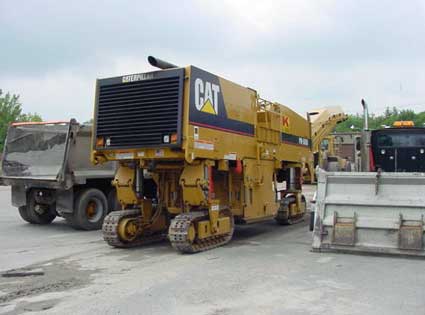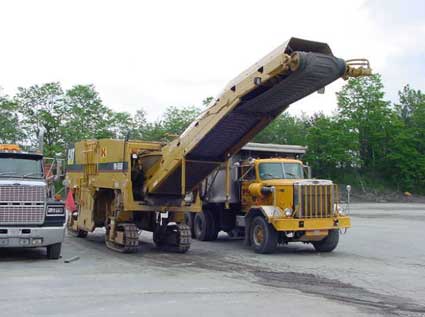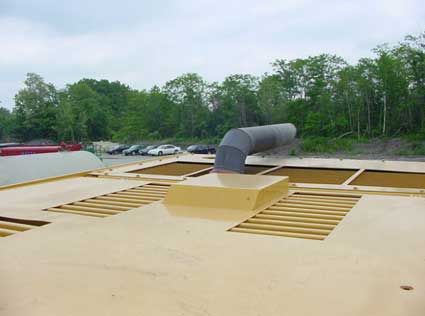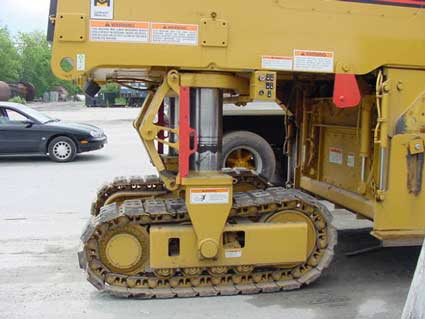Laborer is Killed When Backed Over by Asphalt Milling Machine
Massachusetts Case Report: 03-MA-018-01
Release Date: July 8, 2005
Summary
On June 5, 2003, a 43-year-old male laborer (the victim) was fatally injured when struck by a backing asphalt milling machine. The paving crew had been using the milling machine to grind down a section of a parking lot. The victim was struck while walking alongside the milling machine while the machine was backing. A co-worker yelled to the milling machine operator to stop because the laborer was run over. The milling machine operator and a truck driver, who was on site, attended to the victim. Emergency Medical Services (EMS) were notified and responded to the incident site within minutes. The victim was transported to a local hospital where he was pronounced dead. The Massachusetts FACE Program concluded that to prevent similar occurrences in the future, employers should:
- ensure that there is a clear line of communication between milling machine operators and the assigned ground persons.
In addition, FACE investigators concluded that as a matter of prudent safety practice, employers should:
- ensure that employees have sufficient rest periods between work shifts.
Milling machine manufacturers should:
- give increased attention to machine operator visibility when developing machine designs and operational procedures
- explore the possibility of incorporating new monitoring technology on equipment, which will assist operators while backing.
Introduction
On June 6, 2003, the local media alerted the Massachusetts FACE Program that on June 5, 2003, a 43-year-old male laborer was fatally injured when struck by a milling machine. An investigation was immediately initiated. On June 12, 2003, the Massachusetts FACE Program Director traveled to the roadway and highway paving company’s office where two company health and safety representatives were interviewed. The milling machine involved in the incident was also at this location. The death certificate, corporate information, and OSHA fatality and catastrophe report were reviewed. Photographs of the milling machine were taken during the course of the site visit.
The employer’s primary business was roadway and highway construction projects, stone quarrying, and manufacturing of hot mix asphalt. The company had been in business 80 years at the time of the incident. The company had approximately 270 employees and four office locations; the office location to which the victim was assigned had 92 employees. Of these employees, approximately 50 of them worked in the roadway construction section. The victim had been employed with the company as a “ground guy” or laborer for three years at the time of the incident. The work crew assigned to this project consisted of five employees and had worked together as a crew for one year.
The company employed individuals responsible for safety and health. The company developed and implemented a written safety and health program including safety and health training for employees that was updated annually. Toolbox talks were held regularly at each job location. At the time of the incident, the victim’s personal protective equipment consisted of an orange safety vest, hearing protection, eye protection, and steel toe boots. The victim had union representation.
Investigation
The company had been hired to grind down and repave a parking lot. The project had begun a few weeks prior to the incident, and one section of the parking lot had already been finished. At the time of the incident, the section of the parking lot under construction had been flagged off, allowing the remaining section of the parking lot to be in use during construction.
The machine involved in the incident was a cold milling machine (Figures 1 and 2) that weighed approximately 85,100 pounds with the water tank full. The machine had a diesel engine and four crawler tracks. The milling machine was designed to remove the top layers of worn or deteriorated asphalt, eliminating surface imperfections such as bumps and ruts. The amount of removed asphalt could be selected by adjusting the drum cutting depth. The machine’s cutting width was fixed at 6.9 feet and the length of the milled area depended on the project. During the milling operation, water from the machine’s water tank was used to control dust levels.
During the milling process, the removed asphalt is ground up and discharged via a conveyor that is located at the front of the machine. A dump truck is positioned at the end of the conveyor to collect the discharged asphalt (Figure 2). The dump truck is moved along with the milling machine so discharged asphalt from the milling machine’s conveyor will continuously dump into the truck.
The operator’s area, located on top of the milling machine, had a dual control console. This allowed the operator to control the machine from either the left or right sides of the machine. In addition, the machine was manufactured with warning horns and emergency shutdown buttons that were located within the operator’s area and at five ground level control stations.
On the day of the incident, the victim and his crew members had worked a seven-hour shift that started at 7:00 a.m. and then arrived at the incident work site at 5:30 p.m. for that day’s normal scheduled shift, which started at 6:00 p.m. The area to be milled was a triangular shaped section of a parking lot, measuring approximately ¼ acre. The company provided lighting at the work area for the nighttime work. The victim’s main task during the milling operation was to walk alongside of the milling machine to check on the cutting drum area and to act as a spotter for the operator, due to limited operator visibility (Figure 3) during the milling process and while backing the machine.
Prior to the incident, the work crew had made several same direction passes with the milling machine. After the last pass before the incident, the operator lifted the machine’s cutting drum and waited for the sweeping machine to clean up the remaining milling debris. The victim was standing on the right side of the milling machine and the work crew foreman was standing on the left side of the milling machine. The company representatives reported that the operator then looked back to the right at the victim and the victim nodded to the operator indicating that it was clear to start backing. With a functioning backing alarm, the operator, using the left side controls, started backing in low gear to back over the pile of milling debris located underneath the milling machine. After the machine backed over the debris pile, the operator stopped the machine, switched it into high gear, looked back to his right side, got a second nod from the victim and then proceeded backing. The company representative estimated that high gear for the milling machine was approximately 3 – 4 miles per hour. The purpose of backing the milling machine was to prepare it for the next pass. The machine was initially backed straight and then off to the side and onto the uncut section of asphalt.
The milling machine operator, who was still standing and using the left side controls, was told to stop backing by both the sweeping machine operator and the foreman. He stopped the milling machine immediately and the sweeping machine operator informed him that he had run the victim over. The victim was struck and run over by the milling machine’s right rear track (Figure 4) and the cutting drum. The milling machine operator and a dump truck driver went to assist the victim who was face down with serious injuries to his lower extremities. The milling machine operator and the truck driver turned over the victim and tried to stop his bleeding and performed cardiopulmonary resuscitation (CPR) while a call was placed for emergency medical services (EMS). Within minutes, EMS responded to the incident site and the victim was transported to a local hospital where he was pronounced dead.
It is unknown if the victim nodded to the milling machine operator or if the machine operator responded to a nod that was a head movement not intended for the machine operator. It is also unknown, but very possible, that the victim could have tripped causing him to become caught by the milling machine’s right rear track.
At the time of the investigation, the company was planning on installing cameras at the rear of the milling machine and monitors at the operator’s area. The company had already installed this same type of equipment on a loader at one of its quarry locations and had reported that the loader operator felt that the camera and monitor was very helpful while backing.
Cause of Death
The medical examiner listed the cause of death as multiple injuries, severe.
Recommendations/Discussion
Recommendation #1: Employers should ensure that there is a clear line of communication between milling machine operators and the assigned ground persons.
Discussion: In this case, the employer reported that the milling machine operator and the victim “acknowledged” each other just prior to the incident. The employer stated that the “acknowledgment” was in the form of a head nod by the victim to the milling machine operator meaning that it was “all clear” for the operator to start backing. It is possible that the victim might have not been communicating with the milling machine operator and that the victim’s head movement that was perceived as a nod was not intended for the milling machine operator. To ensure that there is no miscommunication between the ground person and the milling machine operator, there must be a clear line of communication. One way to establish a clear line of communication could be by developing a signaling system that uses more than head nods, such as hand, flags, and light wand signaling. All signals should be standardized, agreed upon, and clearly understood by all employees within the work crew.
Recommendation #2: Employers should ensure that employees have sufficient rest periods between work shifts.
Discussion: Although available information is insufficient to confirm fatigue as a factor in this incident, the possibility of fatigue as a factor should be addressed as a matter of prudent safety practice. The crew’s work schedule on the day of the incident consisted of two shifts, leaving only a few hours of downtime for the workers in between the shifts. This raises concern regarding the ability of the workers to get sufficient rest after the first shift and before returning to work for the second shift of the day. Whenever possible, work should be scheduled to provide workers with a sufficient rest period in between shifts.
Recommendation #3: Milling machine manufacturers should give increased attention to machine operator visibility when developing machine designs and operational procedures.
Discussion: As represented in Figure 3, the milling machine operator, while located in the operator’s area, had very limited visibility of the area immediately around the machine. Designing milling machines to optimize the operator’s visibility of these critical areas around the machine would be beneficial to both the operator and workers on foot.
In this case, if the operator’s area was the highest point on the machine and the surrounding sections of the machine sloped downward away from the operator’s area, this could possibly increase the operator’s field of vision around the machine while located in the operator’s area.
Recommendation #4: Milling machine manufacturers should explore the possibility of incorporating new monitoring technology on equipment that will assist operators while backing.
Discussion: A monitoring system could give the operator a better view and sense of the area around the rear of the vehicle. Since this incident, the company planned to install cameras at the rear of the milling machine and monitors at the operator’s area to assist the milling machine operator while backing, as they have done to a loader at one of their quarries. In addition, other technologies such as fiber optic systems and radio frequency identification (RFID) tags and tag readers are becoming more readily available and could be installed on construction equipment. An RFID system would require that each worker on foot wear a small RFID tag and a tag reader would be mounted on the equipment. When a tag is sensed within the tag reader’s sensing range, the equipment operator would receive a warning.
References
- Code of Federal Regulations, 29 CFR 1926.601 (b)(4) Motor vehicles, Government Printing Office.
- ILO, Safety and Health in Construction: An ILO code of practice, Geneva, International Labor Office, 1992.
- NIOSH FACE Report Number 2002-06, Roadway Construction Worker Dies From Crushing Injuries When Backed Over by a Dump Truck – Virginia.
Illustrations
 |
|
Figure 1 – Rear of the milling machine involved in the incident.
|
 |
|
Figure 2 – Front of the milling machine involved in the incident.
|
 |
|
Figure 3 – View from the operators area looking to the rear of the machine.
|
 |
|
Figure 4 – Right rear track that struck the victim.
|
To contact Massachusetts State FACE program personnel regarding State-based FACE reports, please use information listed on the Contact Sheet on the NIOSH FACE web site Please contact In-house FACE program personnel regarding In-house FACE reports and to gain assistance when State-FACE program personnel cannot be reached.
